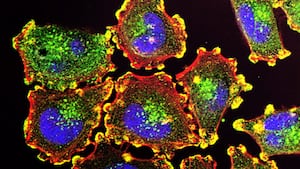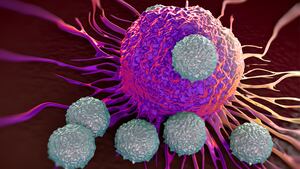Ultrasound is probably best known as a way to observe the body’s insides, like to check up on a growing fetus or detect problems in someone’s heart. But it’s also used to fight cancer by sending high frequency sound waves to fry these abnormal cells. Focused ultrasound is used mostly against localized cancers like prostate. This treatment is about to get a big boost from an unlikely ally: bacteria.
In a new study reported in the journal Nature Communications on March 24, researchers at Caltech genetically modified E. coli bacteria to kill cancer after being activated by ultrasound-induced heat—laying any harm to surrounding healthy cells. These bacteria not only prevented tumors in mice from growing larger, they also managed to cut down a tumor’s size outright. The findings may help clinicians develop a more targeted search-and-destroy method for combating cancer, and might also be adapted later on into helping fight off other infections localized to a specific part of the body.
Using bacteria to wage a battle against cancer may sound out of left field, but scientists have known about bacteria’s strange attraction to cancer since the 19th century, Mikhail Shapiro, a biochemical engineer at Caltech who led the new study, told The Daily Beast. “More than 100 years ago, [American surgeon] William Coley noticed that if you have some bacteria present in a tumor, you can get beneficial anti-tumor effects,” he said. “More recently, people have seen that you can inject certain bacteria into the bloodstream and they will get cleared almost everywhere by the immune system” except where a tumor is, since cancer works hard to weaken the immune system to avoid detection.
Over the years, scientists sought to exploit this bizarre relationship by having bacteria deliver chemotherapy payloads directly to cancer cells. But they ran the risk of harming healthy cells that might cross the bacteria’s path. Shapiro and his team thought they could get around this problem by finding a way to remote control bacteria to nuke cancer cells on command. They realized this could be possible by genetically modifying E. coli to respond to a temperature spike caused by focused ultrasound. When the E. coli are warmed to between 107–109 degrees Celsius, a pair of genes are activated that facilitate the production of anti-tumor nanobodies—engineered molecules similar to antibodies that can disable proteins that keep cancerous cells alive.
To test this out, Shapiro and his colleagues injected the modified E. coli into immunocompromised mice riddled with tumors similar to non-Hodgkin lymphoma. They then applied the focused ultrasound on bacteria-infected tumors and saw that the cancer stopped growing and even significantly shrunk in just two weeks. They also verified that it wasn’t just the bacteria or the ultrasound at play—both components were necessary to stop the tumors from growing.
While promising for mice, this potential cancer treatment still needs more fine-tuning and testing before it can reach the clinical trial phase in humans. Shapiro and his team would like to be able to track the location of the bacteria in the body in real time, and observe the exact moment the E. coli starts killing cancer cells.
“We want to see whether [the bacteria] reached the tumor, are they there, did they establish a colony, and then activate them,” Shapiro said. “Ideally, in the future, we want to be able to see that activity because you don’t want to just wait around to see if the tumor is shrinking or growing.”
Beyond cancer, it may be possible to use this treatment to target diseases that occur in specific locations within the body such as cystic fibrosis (which primarily affects the lungs), “to confine a potent cellular or genetic therapy to that location to minimize side effects,” said Shapiro.
And what’s also great about this new technique is that focused ultrasound devices aren’t hard to find—they’re pretty much in any hospital or cancer clinic in the U.S. Once it becomes easier to produce genetically modified bacteria for clinical application, Shapiro thinks this type of treatment could grow to be a first-line treatment over conventional cancer-fighting interventions.








